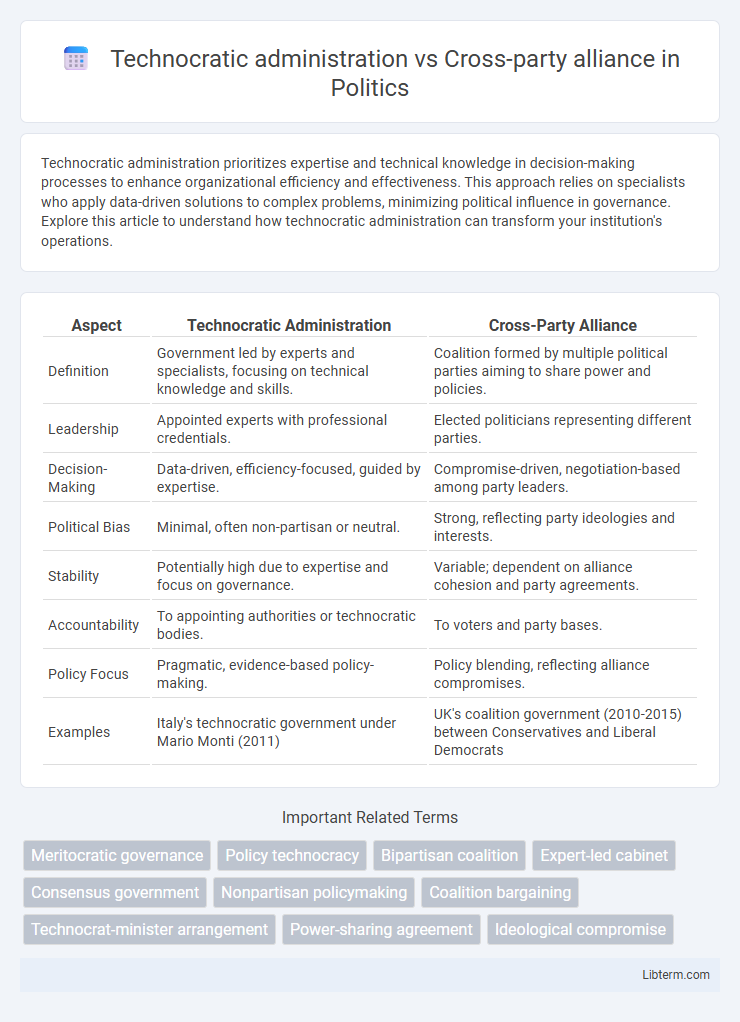Technocratic administration prioritizes expertise and technical knowledge in decision-making processes to enhance organizational efficiency and effectiveness. This approach relies on specialists who apply data-driven solutions to complex problems, minimizing political influence in governance. Explore this article to understand how technocratic administration can transform your institution's operations.
Table of Comparison
| Aspect | Technocratic Administration | Cross-Party Alliance |
|---|---|---|
| Definition | Government led by experts and specialists, focusing on technical knowledge and skills. | Coalition formed by multiple political parties aiming to share power and policies. |
| Leadership | Appointed experts with professional credentials. | Elected politicians representing different parties. |
| Decision-Making | Data-driven, efficiency-focused, guided by expertise. | Compromise-driven, negotiation-based among party leaders. |
| Political Bias | Minimal, often non-partisan or neutral. | Strong, reflecting party ideologies and interests. |
| Stability | Potentially high due to expertise and focus on governance. | Variable; dependent on alliance cohesion and party agreements. |
| Accountability | To appointing authorities or technocratic bodies. | To voters and party bases. |
| Policy Focus | Pragmatic, evidence-based policy-making. | Policy blending, reflecting alliance compromises. |
| Examples | Italy's technocratic government under Mario Monti (2011) | UK's coalition government (2010-2015) between Conservatives and Liberal Democrats |
Defining Technocratic Administration
Technocratic administration refers to a government led by experts and professionals with specialized knowledge, emphasizing efficiency and evidence-based policymaking. Unlike cross-party alliances, which are coalitions formed by political parties to achieve consensus, technocratic administrations prioritize technical expertise over political considerations. This approach aims to address complex issues through informed decision-making, minimizing partisan influence.
Understanding Cross-Party Alliances
Cross-party alliances involve collaboration between multiple political parties to achieve common legislative goals, improving policy stability and broad representation. These alliances often emerge in fragmented parliaments where no single party holds a majority, requiring negotiation and compromise to form effective governance. Understanding cross-party alliances reveals their role in fostering political inclusivity and balancing diverse ideological interests within a coalition government.
Historical Contexts of Governance Models
Technocratic administration emerged prominently during the 20th century, particularly in response to economic crises where experts were appointed to manage complex policy issues, as seen in post-World War II reconstruction and the global financial crises of the 1970s and 2008. Cross-party alliances have historically been formed during periods of political instability or national emergency, such as the coalition governments in the United Kingdom during World War II and the post-war consensus era, aiming to unify divergent political interests. These governance models reflect adaptive strategies to balance technical expertise and political consensus in maintaining stability and effective policy implementation.
Key Characteristics of Technocratic Leadership
Technocratic administration emphasizes leadership by experts with specialized knowledge, prioritizing data-driven decision-making, efficiency, and technical competence over political considerations. Technocratic leaders are typically appointed based on expertise in fields like economics, engineering, or public policy, with a focus on pragmatic problem-solving rather than ideological agendas. This approach contrasts with a cross-party alliance, which relies on political negotiation, coalition-building, and compromise among diverse party representatives to achieve governance.
Political Dynamics of Cross-Party Cooperation
Technocratic administration relies on expert-led governance, minimizing partisan influence to prioritize efficiency and policy expertise. Cross-party alliances emphasize political negotiations among diverse party interests, fostering collaboration despite ideological differences to achieve common legislative goals. The political dynamics of cross-party cooperation involve balancing conflicting agendas, building trust, and leveraging shared objectives to stabilize governance and advance bipartisan reforms.
Decision-Making Processes Compared
Technocratic administration relies on expert-driven decision-making, emphasizing data, technical knowledge, and efficiency, which accelerates policy implementation with minimal political interference. Cross-party alliances involve collaborative negotiation and consensus-building among diverse political actors, often leading to more inclusive but slower decision-making processes due to conflicting party interests. The technocratic approach prioritizes evidence-based solutions, whereas cross-party alliances balance competing political agendas to achieve broader legitimacy.
Benefits and Drawbacks of Technocracy
Technocratic administration offers the benefit of expertise-driven decision-making, resulting in more efficient and evidence-based policies that can address complex issues with technical precision. However, its drawbacks include potential democratic deficits, as technocrats may lack direct electoral legitimacy and can be perceived as disconnected from the public's needs and values. Contrastingly, cross-party alliances foster broader political representation and consensus-building, but often face challenges such as slowed decision-making and compromised policy effectiveness due to competing party interests.
Advantages and Challenges of Cross-Party Alliances
Cross-party alliances foster broader political consensus and inclusive governance by integrating diverse perspectives from multiple parties, which enhances policy stability and social cohesion. However, managing conflicting party interests and ideological differences can lead to delays in decision-making and compromises that dilute policy effectiveness. The complexity of coalition-building demands skilled negotiation and continuous dialogue to sustain cooperation and achieve shared objectives.
Case Studies: Global Examples of Both Systems
Technocratic administrations, such as Italy's 2011 Monti Cabinet, rely on expert-led governance to address economic crises without partisan influence, exemplifying efficiency in policy implementation. In contrast, cross-party alliances like Germany's grand coalition between CDU/CSU and SPD facilitate political stability and broad consensus during legislative stalemates, often balancing diverse party interests. Comparative studies reveal technocratic models excel in rapid reform scenarios, whereas cross-party coalitions sustain long-term parliamentary cooperation in multiparty democracies.
Future Prospects: Towards Efficient and Inclusive Governance
Technocratic administration leverages expert knowledge and data-driven policies to enhance decision-making efficiency, potentially streamlining governance and improving public service delivery. Cross-party alliances foster inclusivity and political stability by combining diverse perspectives and interests, which can lead to more comprehensive and representative policymaking. Future governance models may benefit from integrating technocratic precision with cross-party collaboration to balance effectiveness and inclusiveness, addressing complex societal challenges more holistically.
Technocratic administration Infographic

 libterm.com
libterm.com